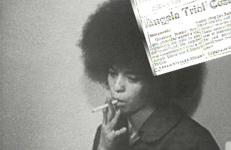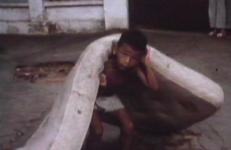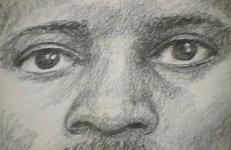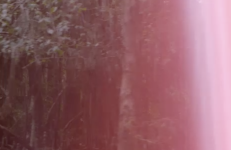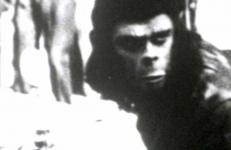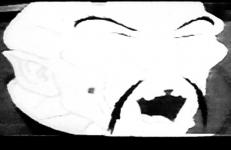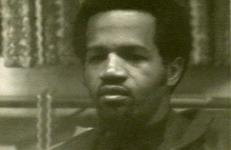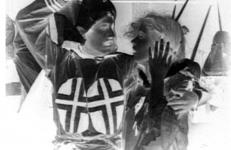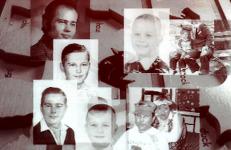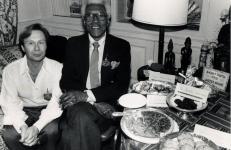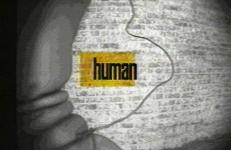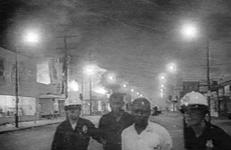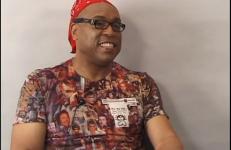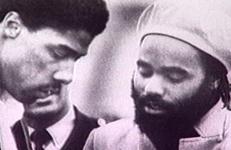19 out of the 41 shots fired in 10-seconds by four members of the NYPD Street Crimes Unit hit the defenseless body of one Amadou Diallo as he stood in the vestibule of the building where he lived in the Bronx. This video essay seizes on the grotesquely bald, factual precision of this numerical data, proceeding remorselessly on up from number 1 to 41, rubber-banding 10-seconds into fourteen minutes, and then snapping it tight, in an intense, formal contemplation of how police violence is produced and then addressed by other forces on the city streets.
Race
19 out of the 41 shots fired in 10-seconds by four members of the NYPD Street Crimes Unit hit the defenseless body of one Amadou Diallo as he stood in the vestibule of the building where he lived in the Bronx. This video essay seizes on the grotesquely bald, factual precision of this numerical data, proceeding remorselessly on up from number 1 to 41, rubber-banding 10-seconds into fourteen minutes, and then snapping it tight, in an intense, formal contemplation of how police violence is produced and then addressed by other forces on the city streets.
A Pilot For A Show About Nowhere is a two-channel video that examines the politics of television viewership, incorporating footage from a number of sources to create a plurivocal narrative.
a/k/a Mrs. George Gilbert extends Coco Fusco’s in-depth examination of racialized imagery. Fusco combines fictional and documentary source materials to reflect on the use of electronic surveillance against Black intellectuals and activists in the 1960s and 1970s as part of covert FBI operations. These actions bear a striking resemblance to contemporary Patriot Act-inspired activities of American law enforcement.
Snapshots of individuals from all parts of Asia and the Pacific Islands form a stream of images that blankly proves the fallacy of the title phrase. Soe challenges viewers to recognize the failure of vision that underlies this common misperception, and the failure of understanding that creates and propagates such generalizations.
Spanish subtitled version available.
amaurosis is an experimental documentary about Dat Nguyen, a blind guitarist living in Little Saigon, Orange County, California. Dat Nguyen was a "triple outcast": blind, Amerasian, and an impoverished orphan. His American father left Viet Nam in 1973, and his mother died in 1975. Living on the streets of Saigon, he sold lottery tickets for food money. At the age of 12, Dat met a classical music teacher who was also blind and who taught him to read Braille as well as supported him.
The Diaspora Suite
Oscillating between a street festival in Philadelphia, the slave forts and capitol city of Ghana, and the New Jersey shore, American Hunger explores the relationship between personal experience and collective histories. American fantasies confront African realities. African realities confront America fantasies.
And They Came Riding Into Town on Black and Silver Horses looks at how media representations shape our perception of violence and violent crime, in effect creating racist stereotypes. Andrews suggests that the evidence against young Black men is gathered not at the scene of the crime, but at the scene of representation.
For four years in the 1860’s, half of the United States was held hostage by an unrecognized white supremacist republic. Shot on 16mm in national military parks, swamps, forests and the suburban sprawl across the former battlefields, the film follows General Grant’s path liberating the southern United States. Part travelogue, part essay film, part landscape documentary, it moves from the Texas-Louisiana border to a prison island off the coast of New England.
Employing footage from an obscure 8mm film trailer for Battle for the Planet of the Apes to highlight the unstable relationship between the real, historical past and the distant, imaginary future, this project revolves around a central question: Is alien-ness indeed the metaphor for the 20th Century as power relationships have been embodied within our subconscious? Is there a relationship between these forgotten formats and the discontinued political ideologies that they depict?
Featuring Arnold and Ahneva from Wendy Clarke's One on One video series, this video dialogue deeply connects the pair through discussion of Black brother and sisterhood. The two find comfort in sharing their own creative individualities, endeavors, and dreams. Their discussion and newly formed relationship poignantly touches upon the impact of mass incarceration within the Black community.
Asian Studs Nightmare examines the racial politics behind the hit U.S. television show STUDS. Fulbeck frantically recalls somewhat fictional nightmares of Asian male identity. Over a multi-layered visual of the actual STUDS show and Asian male stereotypes, Asian Studs reveals the pervasive racial hierarchies and taboos depicted in mass media and probes their relation to interracial dating patterns and minority status in the United States.
Portable Channel, a community documentary group in Rochester, New York, was one of the first small format video centers to have an ongoing relationship with a PBS affiliate (WXXI). Portapakers interviewed Sinclair Scott, a member of the negotiating team that went into Attica when the prisoners' rebelled at the federal prison in September 1971. Thirty-eight guards were taken hostage after prisoners' demands to improve their conditions were ignored. After a three day stand-off between inmates and authorities, Governor Nelson Rockefeller called in the National Guard.
Backwards Birth of a Nation is a re-editing of D.W. Griffith's 187-minute film, Birth of a Nation (1915), into a pulsating 13-minute black and white phantasm. By means of structural strategies of condensation, the frame by frame inversion of black and white, and playing the resulting work from end to beginning, an apparition is brought forth where images of racism float to the surface and are contextualised as a part of the flow of United States history.
Based on a Story explores the widely-publicized encounter between a Jewish Cantor, Michael Weisser, and Nebraska's former Ku Klux Klan Grand Dragon, Larry Trapp. After months of harassment from Trapp by mail, phone and cable TV, the Weisser family befriended Trapp, who then renounced the Klan, moved into the Weisser family's home and converted to Judaism. Trapp, who was a double amputee and blind from childhood diabetes, died in the Weisser's home six months after he moved in.
Based on a Story explores the widely-publicized encounter between a Jewish Cantor, Michael Weisser, and Nebraska's former Ku Klux Klan Grand Dragon, Larry Trapp. After months of harassment from Trapp by mail, phone and cable TV, the Weisser family befriended Trapp, who then renounced the Klan, moved into the Weisser family's home and converted to Judaism. Trapp, who was a double amputee and blind from childhood diabetes, died in the Weisser's home six months after he moved in.
In the late 1970s, Walter Naegle was walking to Times Square to buy a newspaper when he ran into a striking older African American man on the corner. Walter says that “lightning struck” and his life changed forever at that moment. The man on the corner was Bayard Rustin.
Black Body is a harsh and compelling meditation on the contradictory values assigned to black bodies in American culture: they exist as both desired and feared, abject and powerful. The “black body” is a body whose surface reflects projected fears and repressed desires; as such, it exists as a site of ideological struggle, a surface which is simultaneously eroticized and denegrated.
Subtitled A Rebellion against the Commodity, this engaged reading of the urban black riots of the 1960s references Guy Debord’s Situationist text, “The Decline and Fall of the Spectacle-Commodity Economy,” Internationale Situationniste #10 (March 1966). Along with additional commentary adapted from Barbara Kruger and musicians Morrissey and Skinny Puppy, the text posits rioting as a refusal to participate in the logic of capital and an attempt to de-fetishize the commodity through theft and gift.
Black Code / Code Noir unites temporally and geographically disparate elements into a critical reflection on two recent events: the murder of Michael Brown and that of Kajieme Powell by American police officers in 2014. Archaeologically, the film argues that behind this current situation is a sedimented history of slavery, preserved by the Black Code laws of the colonies in the early Americas. These codes have transformed into the algorithms that configure police Big Data and the necropolitical control of African-Americans today. Yet how can we read this in the present?
Company Line is a film about one of the first predominately Black neighborhoods in Mansfield, Ohio. The title, Company Line, refers to the name historically used by residents to describe their neighborhood, located on the north side of town close to the old steel mill. The Company Line began during the post–war migration of Blacks from the south to the north in the late 1940’s. The neighborhood was purchased in the early 1970s and its residents were scattered throughout Mansfield.
In this interview, American artist, independent curator, writer, and experimental filmmaker, Vaginal Davis reflects on her initiation into the punk rock and art scenes of Los Angeles during the 1980s and 90s, her stylistic influences, and her ongoing efforts to theorize queerness and visuality. Caught between the opposing poles of Hollywood classicism and the rawness of punk, Davis defines her unapologetically gender-bending, campy, and at times aggressively critical performances as scenarios, rather than spectacles or entertainment.
Deathrow Notebooks is structured around an interview with Mumia Abu-Jamal, a political prisoner who is on death row in Pennsylvania. Former president of the Association of Black Journalists, Abu-Jamal is a writer and creator of widely-broadcast radio programs who continues to write from prison. He was accused of killing a police officer, and in 1982 was convicted in a trial that contained many irregularities. To date, all of his appeals have failed.
Deathrow Notebooks is structured around an interview with Mumia Abu-Jamal, a political prisoner who is on death row in Pennsylvania. Former president of the Association of Black Journalists, Abu-Jamal is a writer and creator of widely-broadcast radio programs who continues to write from prison. He was accused of killing a police officer, and in 1982 was convicted in a trial that contained many irregularities. To date, all of his appeals have failed.
Paul D. Miller (b. 1970) is a conceptual artist, writer, and musician better known as DJ Spooky. A popular and prolific recording artist, he has collaborated with Ryuichi Sakamoto, Butch Morris, Yoko Ono, Thurston Moore (of Sonic Youth), Kool Keith, and Killa Priest (of Wu Tang Clan). Miller’s work uses a wide variety of digitally created music as a form of postmodern sculpture.






